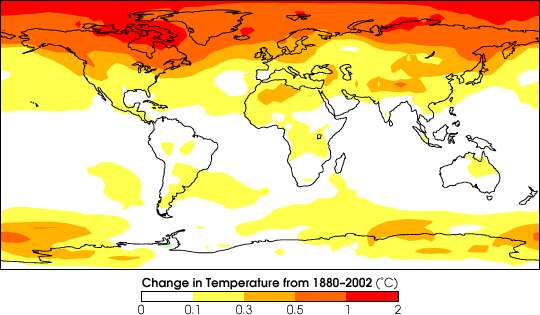
Countdown to Earth Day
April 6, 2004
align="center">
Photo credit: NASA
New research from NASA and Columbia University climate scientists shows that more than 25 percent of the increase in average global temperature between 1880 and 2002 may be due to soot contamination of snow and ice worldwide. Pure snow and ice can be blindingly bright, reflecting large amounts of incoming radiation back into space, whereas snow and ice that is contaminated with black carbon absorbs incoming solar radiation. The scientists estimate that a soot content of only a few parts per billion (ppb) can reduce snow’s ability to reflect incoming radiation by 1 percent. In North American, soot has reduced snow’s reflectivity by 3 percent [Earth Observatory News].
The Earth is warming rapidly. Over the past 2 - 3 million years the Earth’s climate has swung back and forth between ice ages and interglacial periods of relative warmth. The current interglacial period (the Holocene) has been in place for 12,000 years - longer than most, as reflected in the 400,000-year temperature record preserved in the Antarctic ice sheet. In other words, the Earth should be getting cooler, but it isn’t.
The causes of this warming are several - one is spotlighted in the image above. Even more effective at increasing the planet’s surface temperature is the amount of “greenhouse” gases (methane, carbon dioxide, chlorofluorocarbons, and water vapor) in the atmosphere. These gases are transparent to the sunlight that hits the Earth, but are opaque to the infra-red radiation that the Earth’s surface re-radiates back into space. It’s the same effect as seen in a glass greenhouse (hence the name). The more of these gases in the atmosphere, the more heat that gets trapped down where we live.
A lot has been said about the amount of greenhouse gases humans are releasing into the air, and the question of how much an affect this has on the observed warming. After all, the amount of carbon dioxide resulting from human activities is just a tiny fraction of the total carbon budget for the planet. However, it should be remembered that Earth’s pre-industrial climate was in balance with the natural level of carbon dioxide (and the other gases). Human activities have been “tipping the scales” of this natural balancing act - and a number of studies have shown that small changes to the planetary carbon budget, if maintained long enough, can result in large climate changes.
To learn more about Earth’s “Carbon Cycle”, visit these sites:
The Fundamentals of Physical Geography: an On-line Textbook from Okanagan University College, British Columbia.
http://www.physicalgeography.net/fundamentals/9r.html
The Woods Hole Research Center.
http://www.whrc.org/science/carbon/carbon.htm
For more on our current understanding of Global Warming and its likely impacts to human life, visit The U.S. Global Change Research Information Office.
Tomorrow, we’ll look at the likely impacts of global warming.